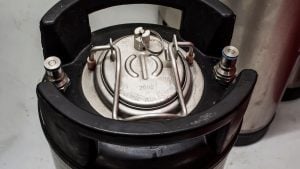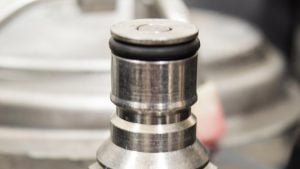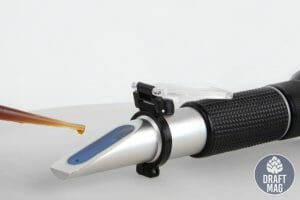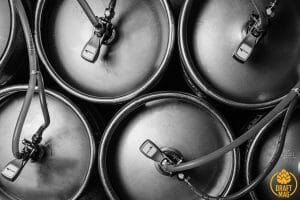Ball Lock vs Pin Lock: What’s the Difference Between These Systems?
 This ball lock vs pin lock comparison guide will give you the details to help you choose the right homebrew keg locks. Corny kegs are among the most popular and most accessible kegs for homebrewers.
This ball lock vs pin lock comparison guide will give you the details to help you choose the right homebrew keg locks. Corny kegs are among the most popular and most accessible kegs for homebrewers.
We will take an in-depth look at the differences and similarities between pin lock and ball lock kegs to help you decide the one that is best for you.
Quick Overview – Comparison Table
Here is a quick overview table of their similarities and differences.
| Ball Lock System | Pin Lock System | |
| Dimensions | Approximately 25 inches tall and 8.5 inches in diameter | Approximately 22 inches tall and 9 inches in diameter |
| Pressure Relief | Pressure relief valve is present on the lid | Requires the user to press down the keg post gas connection center for depressurization |
| Fittings | Uses rings of balls for secure connections | Uses two- and three-pin port connectors |
| Lids | Both have equal and interchangeable dimensions | Both have equal and interchangeable dimensions |
| Keg Posts | Has two primary sizes — 7/8-inch and 11/16-inch, compatible with both 6-point and 12-point sockets | Standard post size is 13/16 inches; always requires the use of special notched sockets |
| Quick Disconnects (QDs) | Comes with a ball mechanism to remain locked into place; shorter | Uses notches to keep it locked in place on the pins present on each post; longer |
| O-rings | Similar lid O-rings and dip tube O-rings | similar lid O-rings and dip tube O-rings, slightly larger post O-rings |
Ball Lock vs Pin Lock Kegs: What Are Their Main Differences?
The main differences between Ball Lock and Pin Lock keg systems are in their sizes and dimensions as well as how they work. We’ll focus on the 5-gallon kegs because they are the most widely used size. However, both kegs come in various sizes including 10, 5, 3, 2.5 and 1.75 gallons.
Ball lock keg height is thinner and taller, while pin lock kegs are broader and shorter.
- Ball lock keg dimensions – approximately 25 inches tall and 8.5 inches in diameter.
- Pin lock keg dimensions – approximately 22 inches tall and 9 inches in diameter.
You don’t want to choose a keg that’s bigger than your keg storage space, so you should consider this vital difference.
– Pressure Relief
Another major difference is the pressure relief valve present on the lid of the ball lock kegs. On the other hand, pin lock kegs require the user to press down the keg post gas connection center for depressurization. While this is often not a problem, many homebrewers consider it too challenging.
– Fittings
In addition, the “gas-in” and “liquid-out” fittings on pin lock systems are different. A pin lock keg uses two- and three-pin port connectors. The two pins are for the “gas-in” port, while the three pins are for the “liquid-out” port. These pins fit into gas line slots and liquid line connectors and intend to prevent the bubbling up of gas through the beer without dispensation.
Pin lock Corny kegs are designed in such a way that you can easily convert them to ball lock kegs. However, their parts are less widely available than ball lock parts, so you need to consider this difference when you’re looking to invest in a keg system. Moreover, ball lock kegs use rings of balls for secure connections, while pin lock connectors have the “tongue and groove” kind of setup.
Their internals are nearly identical. Both pin and ball lock kegs have side and center pick-up tubes, but this should not influence your decision because they perform similarly.
Pin Lock vs Ball Lock Keg Systems: How They Work
CO2 gas flows through the “gas-in” outlet, putting pressure on top of the keg. The liquid is forced out of the “liquid-out” outlet by this pressure provided directly to it.
The fittings on the keg’s top in the ball-lock system are slightly different from one another, but unless you take a very close look at the two options, it’s difficult to discern the difference between them. You can only use matching gas fitting with the “gas-in” fitting, not a liquid line fitting.
If you disassemble your keg to clean it, the port fittings may appear the same, which can be confusing. You can have difficulties distributing your beer if you install the wrong fittings on the wrong sides. This is the fundamental argument against ball-lock fittings, but the issue can be easily avoided if you understand the differences between the two fittings that appear identical.
Pin Lock vs Ball Lock Lids
 Generally, both pin and ball lock lids have equal dimensions, and they are interchangeable. Therefore, you can make use of the pin lock lid on a ball lock keg and the other way around. The major difference here is the function of the pressure relief valve (PRV). Whenever there is too much pressure, both lids automatically vent.
Generally, both pin and ball lock lids have equal dimensions, and they are interchangeable. Therefore, you can make use of the pin lock lid on a ball lock keg and the other way around. The major difference here is the function of the pressure relief valve (PRV). Whenever there is too much pressure, both lids automatically vent.
The pull ring available on ball lock keg lids allows for manual venting of the keg, so you can do it either to release excess pressure or aim to remove the lid of the keg. This is the advantage of having manual PRV valves. There is a need to press the keg post gas connection for pin lock lids to release pressure.
A less common lid style is the racetrack style. However, you cannot interchange it with regular lids.
Ball Lock vs Pin Lock Keg Posts
There is a standard pin lock post size available, which is 13/16 inches. These posts always require the use of special notched sockets.
On the other hand, standard ball lock posts have two primary sizes — 7/8-inch and 11/16-inch posts. These posts are compatible with both 6-point and 12-point sockets. Other rare sizes include 5/8 inches and 9/16 inches, which are preferably called non-standard variants.
Ball Lock vs Pin Lock Quick Disconnects (QDs)
These keg systems probably got their names from the quick disconnects. The ball lock quick disconnects come with a ball mechanism, causing them to remain locked into place.
The pin locks quick disconnects, on the other hand, use notches to keep them locked in place on the pins present on each post. A glance at the QDs, and you’d notice that the ball lock QDs are quite shorter than pin lock QDs.
Generally, you also have the choice of two tubing connections — Male Flare Connections (MFL) and Barbed, both of which measure ¼ inches. The MFL connections are excellent choices because they allow you to remove the tubing easily. However, some homebrewers prefer barbed connections when it comes to gas lines.
Barbed/clamped connections may not loosen up, but MFL connections do. A liquid line can help you quickly notice a leak so that you can tighten the MFL nut whenever you suspect the beer leaking. This is not the case with gas lines because leaks are usually invisible, so barbed connections are best for more security, while flare connections are best for convenience.
A shorter QD profile will be an excellent option if you had a pin lock keg and the total height seems to be a concern. The two quick disconnects systems have similar general components, which include O-rings, screw-on caps, spring, body and stem.
Ball Lock vs Pin Lock O-Rings: Are They the Same?
Standard ball locks and pin locks use similar lid O-rings and dip tube O-rings, but their post O-rings are different. The post O-rings on standard pin lock kegs are slightly larger than those on ball lock kegs. The pin lock O-rings often extend a little bit further out than ball lock O-rings. Also, ball lock O-rings almost flush the lip of the post.
Can You Convert Pin Lock to Ball Lock?
As we mentioned earlier, interchanging ball lock and pin lock is possible. However, it is much easier to convert pin lock to ball lock kegs. The CornyKeg conversion kit allows you to easily convert your pin lock kegs to a ball lock keg.
The kit usually contains the following components:
- Liquid and gas post fittings
- Universal Poppets
- Two O-rings for post fittings
- Two O-rings for gas and liquid tubes
- Thread size on the fittings
You have to first settle on a keg system you wish to use. The ball lock style is often readily available, and most homebrewers choose it. In addition, most kegerator conversion kits often also come with ball lock connections, so these are usually the obvious choices.
What Are Corny Kegs?
Corny kegs, short for Cornelius kegs, were initially used by soda-making industries for distributing their drinks across the United States. However, soda companies have mainly abandoned corny kegs in favor of significantly less expensive Bag-In-Box (BIB) packaging containing concentrated syrup.
As a result of the soda industry’s decision, many kegs that were in circulation were offered to homebrewers to help keg their beer instead. These kegs are ideal for homebrewing since they can withstand pressures far more significant than what beer requires.
In addition, they are made of stainless steel and are relatively inexpensive. With all that being said, they are virtually found everywhere now.
Ball Lock and Pin Lock Keg Systems
Historically, there has always been a two-way division of Corny kegs. For example, Coca-Cola employed pin locks with a fuse-style valve for pressure relief. On the other hand, Pepsi and other soft drinks manufacturers utilized ball locks in the past.
Pin lock kegs use pins to fasten gas on the keg fittings and liquid line fittings to the kegs. In contrast, ball lock kegs use ball bearing rings to secure both liquid and gas connections to the keg.
Ball Lock vs Pin Lock Keg Systems: Which One to Choose
Most homebrewers find it hard to pick between these keg systems, and they will often say neither one is better than the other. Ball lock and pin lock kegs are very similar, with both having liquid and gas dip tubes. They will ensure your beer remains carbonated, saving you from the stress of bottling. With these Corny kegs, your brew cave tends to look more legitimate.
– Finding Replacements
However, there may be reasons to choose one style over the other. One of these reasons is the ease of finding or replacing the keg parts. Most kegs available in the market today have a ball lock system. Moreover, most traditional brewing equipment are designed for ball locks. Thus, it is much easier to find their parts.
Pin lock kegs would also be great because they allow you to differentiate between connection posts — three pins for “liquid out” fittings and two pins for “gas-in” fittings. Unfortunately, ball locks may also be relatively more expensive than pub locks.
– Space Requirements
Another important factor you should consider is the space available in your keezer or kegerator. If you have space for the wider ball lock keg, then it should be the obvious choice. However, if you need space for more homebrew tools, the pin lock keg may be the best fit.
Finally, fitting pin lock kegs after cleaning is a bit easier than with the ball lock counterpart. The decision of choosing ball lock or pin lock kegs for most homebrewers is often highly influenced by the cost, ease of finding, and available parts. The most practical consideration is usually what system they find first when bargaining.
Conclusion
 Ball lock and pin lock Corny kegs provide homebrewers with top options for their brew. However, choosing between these keg types may be a daunting task. We have done all the work for you and presented you with the essential details of these keg systems.
Ball lock and pin lock Corny kegs provide homebrewers with top options for their brew. However, choosing between these keg types may be a daunting task. We have done all the work for you and presented you with the essential details of these keg systems.
- Corny kegs are one of the ideal options for homebrewing because they withstand greater pressures than beer requires.
- Ball lock and pin lock keg systems are the two broad divisions of Corny kegs.
- Both keg styles generally work in the same way, with CO2 gas flowing through their gas inlets to put pressure on the top of the keg. Then, the beer is forced out from the other outlet.
- The major difference between the keg systems is in their sizes and dimensions. However, the 5-gallon kegs are the most commonly used.
- Pin lock kegs are shorter and wider, while ball lock kegs are taller and thinner.
- Pin lock kegs use pins to fasten gas and liquid line on the keg fittings, while ball lock kegs use rings of ball bearings for securing gas and liquid connections to the keg.
- Another difference between the keg systems is the kind of pressure relief valve present. Ball lock has a manual option, while you would need to press the center of the gas post connection to depressurize pin lock kegs.
- Their lids are of the same dimension, but the keg posts and quick disconnects (QDs) slightly differ.
- While their lid and dip tube O-rings are similar, their post O-rings are different. Pin lock kegs have slightly larger standard post O-rings than ball lock kegs.
- Conversion kits allow you to convert one keg system to another. However, it is easier to convert the pin lock system to a ball lock system.
- Your choice of keg system will depend on factors like cost, ease of finding, space available in the kegerator, etc.
The information in this article will help you make informed decisions when choosing a keg system for your homebrew.






